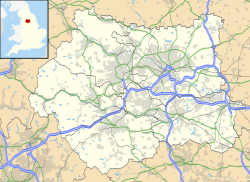Excavations
In 1743 the foundations of a temple were uncovered "with many beautiful ornamented bricks, and an altar, having a patera at the summit, on one side a cornucopia, and an original staff on the other. The edifice had been dedicated to the goddess Fortune, by one Antonius Modestus or Modestinus, of the sixth conquering legion". [7] [8]
The Huddersfield Archaeological and Topographical Society, whose secretary was George Lloyd, excavated the site in 1865. It excavated the remains of a residence measuring 60 feet (18 m) by 68 feet (21 m) with a courtyard. Nearby was a cremation site and on the slope 80 yards (73 m) below the house are the remains of a hypocaust for the hot air bath. Also found nearby were a British stone axe, pottery, part of a brooch and a quantity of galena, (lead ore). [6] A druidic 'rocking stone' was found with these on Golcar Hill. [9] On another part of the site are the remains of a cold bath comprised a slab of concrete 13 feet 6 inches (4.1 m) long by 6 feet 3 inches (1.9 m) wide. The room it was in had a red tiled floor. Copper or bronze coins from the reigns of Vespasian and Nerva, an earthenware jar and a tile stamped "COH IIII BRE" were also uncovered. [10]
Excavations between 1913 and 1915 and 1958 to 1963 uncovered the fort's ramparts and the foundations of its gateways and corner towers. The ramparts, constructed of turves on a stone footing, surrounded an area 356 feet (111 metres) square. They were surrounded by a ditch, in some parts a double ditch when the fort was built in about AD 79. Inside are the outlines of several wooden buildings including the military headquarters and barrack blocks. Another phase of development about 20 years later added two granaries roofed with tiles stamped COHIIIIBRE, the mark of the 4th cohort of Breuci who operated a tilery in the nearby Grimescar Valley. A phase of building in stone began in the early AD 120s. but by then the garrison had been reduced. The fort was occupied until about AD 140. [4]
Outside the fort to the east was the bath-house and to the north was a small civilian settlement which may have continued until AD 200. [4]
The Tolson Museum in Huddersfield has a collection of artefacts including the reconstructed Grade II listed remains of the hypocaust, comprising the rubble columns and tiled floor, that were moved to Ravensknowle Park from the fort. [11]
This page is based on this
Wikipedia article Text is available under the
CC BY-SA 4.0 license; additional terms may apply.
Images, videos and audio are available under their respective licenses.
